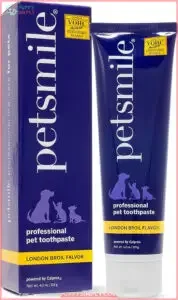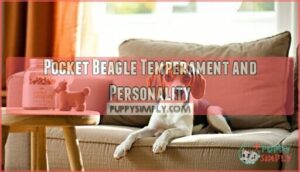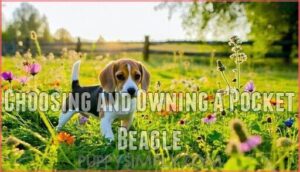This site is supported by our readers. We may earn a commission, at no cost to you, if you purchase through links.

The pocket beagle packs all the classic hound personality—those soulful eyes, that unstoppable nose, and that signature bay—into a frame that maxes out around 12 inches tall.
These compact companions aren’t just scaled-down Beagles; they’re energetic, surprisingly vocal dogs with specific care needs that don’t always match their adorable appearance. Whether you’re drawn to their portability or their rich hunting heritage, understanding what makes pocket beagles tick will help you decide if this pint-sized hound fits your lifestyle.
Table Of Contents
Key Takeaways
- Pocket Beagles are a historically legitimate miniature version (7-13 inches, 7-18 pounds) that trace back to 15th-century English nobility, not a modern designer breed, though they lack official AKC recognition as a separate breed category.
- These compact hounds inherit the full Beagle personality—energetic, vocal, scent-driven, and stubborn—requiring consistent training, 30-45 minutes of daily exercise, and patience for their howling tendencies despite their small, apartment-friendly size.
- Health vigilance is critical since Pocket Beagles face elevated risks for genetic conditions (dwarfism, patellar luxation, IVDD, epilepsy) and common issues like ear infections and obesity, though proper care supports a 12-15 year lifespan.
- They’re excellent family dogs with kid-friendly temperaments and pack mentality, but their separation anxiety and need for companionship make them poor candidates for owners working long hours without dog sitters or daycare solutions.
What is a Pocket Beagle?
You’ve probably heard of Beagles, but what about their pint-sized cousins? Pocket Beagles are a smaller version of the classic breed, with a rich history that stretches back centuries.
So what sets these compact hounds apart from standard Beagles, and where did they actually come from?
Breed Definition and Origins
 View On Amazon
View On Amazon - Ancient Roots: The term "beagle" emerged in medieval times as a catch-all for small hounds with hunting heritage.
- Royal Connections: Pocket Beagles were first bred in the 15th Century, gaining fame through Queen Elizabeth I’s fondness for these tiny hunters.
- Genetic Lineage: Modern Pocket Beagle characteristics trace back to the 11th Century when William the Conqueror brought the Talbot Hound to Britain, shaping the breed standard we recognize today.
Historical Significance
Throughout European history, Pocket Beagles symbolized wealth and power among royalty. Queen Elizabeth I kept them as "singing beagles" and even let them entertain guests at royal feasts, cementing their status beyond hunting.
Their hunting prowess made them invaluable—small enough to slip through dense underbrush where larger hounds couldn’t follow. But as hunting practices evolved toward speed-focused methods, Pocket Beagle popularity declined.
The original bloodline eventually vanished in Britain, though the National Beagle Club of America and British Kennel Club now recognize preservation efforts to maintain this historic breed. The breed’s history and characteristics, such as their small size origins, are essential to understanding their value and appeal.
Pocket Beagle Vs Standard Beagle
When comparing these two dogs, the size difference is striking. Pocket Beagles stand just 7 to 12 inches tall and weigh 7 to 15 pounds, while Standard Beagles reach 13 to 15 inches and tip the scales at 20 to 25 pounds.
Here’s what sets them apart:
- Breed Recognition: Only Standard Beagles earn official American Kennel Club recognition, while Pocket Beagles fall outside the breed standard
- Physical Features: Miniature Beagle varieties often show narrower muzzles, wider heads, and more prominent eyes than their standard cousins
- Health Differences: Pocket Beagles face higher risks of dwarfism, patellar luxation, and intervertebral disc disease due to their compact size
- Exercise Needs: Both need daily activity, but Pocket Beagles require gentler play—two 20-minute walks and 30 minutes of playtime keeps them happy
Despite these differences, both types share that signature Beagle personality: playful, affectionate, and occasionally stubborn during Training Methods sessions. To maintain their health, Beagles require regular veterinary care and a balanced diet.
Pocket Beagle Physical Characteristics
Pocket Beagles pack a whole lot of personality into a pint-sized frame, and their physical traits are just as charming as their temperament.
Their compact bodies and droopy ears give these little hounds a look that’s all their own. Here’s what defines the Pocket Beagle’s appearance.
Size and Weight
If you’ve ever wondered just how tiny these pint-sized hounds really get, the numbers might surprise you—Pocket Beagles clock in at a mere 7 to 13 inches tall and tip the scales between 15 and 18 pounds.
That’s roughly 25% smaller than their standard cousins, making them perfect for apartment living or anyone who wants Beagle charm without the bulk.
Their compact build packs serious muscle into a petite frame, giving them surprising strength for their size.
Coat Colors and Texture
One glance at a Pocket Beagle’s coat and you’ll notice they rock the same classic hound colors as their bigger relatives—think tricolor combos of white, brown, and black, plus variations like red and white, lemon, or even black and tan.
Their coat texture is short and dense, almost velvety to the touch, which makes grooming pretty straightforward. You’ll deal with moderate shedding year-round, so regular brushing—about twice a week—keeps loose fur under control and their coat looking sharp.
Distinctive Features (Ears, Eyes, Tail)
Those droopy, silky ears aren’t just adorable—they’re a signature Pocket Beagle trait that gives them their classic hound-dog charm and surprisingly sharp sense of smell. Their large, expressive brown eyes practically radiate curiosity and warmth, making it tough to say no to that pleading look.
The tail carriage sits high and proud, often wagging like a little flag when they’re excited. These facial expressions and head shape—slightly domed with a gentle stop—are what make this miniature dog breed instantly recognizable and totally irresistible.
Breed Standards
Pocket Beagle breed standards get complicated fast. Major kennel clubs like the American Kennel Club don’t officially recognize them as a separate breed—the AKC’s Beagle standards only cover two size categories: under 13 inches and 13–15 inches, leaving Pocket Beagles (which fall below both) in an unofficial gray area.
Some registries, like the Olde English Pocket Beagle Registry, set their own guidelines focusing on healthy miniature dog breeds without dwarfism traits, though breed classification remains unofficial and standards vary widely among breeders.
Pocket Beagle Temperament and Personality
If you’re wondering whether a Pocket Beagle is the right fit for your home, their personality is where the magic happens. These little hounds pack a ton of charm, energy, and affection into their compact frames.
Here’s what you need to know—from their behavior around family to their response to training.
Family-Friendliness
Pocket Beagles squeeze all the heart of a standard hound into a compact frame, which is exactly why families looking for an affectionate, energetic companion keep coming back to this breed.
Their instinct to be part of the pack translates perfectly to family life—they want to be wherever you are, doing whatever you’re doing. You’ll notice they warm up to visitors pretty quickly, greeting new faces with tail wags instead of suspicion.
Here’s what makes them shine as family pets:
- Kid-friendly temperament: They’re naturally playful and patient, creating strong bonds with younger family members
- Pack mentality: Their hunting heritage means they genuinely enjoy being surrounded by their human "pack"
- Adaptable companions: Whether you’re city-dwellers or suburban families, they adjust to different living situations with ease
- Social butterflies: They’re among the best family dogs for households that want a pet who gets along with everyone
- Low aggression: Despite their hunting roots, they’re more likely to make friends than pick fights
Behavior With Children
When your kids ask if they can roughhouse with your Pocket Beagle, the answer’s almost always yes—these sturdy little hounds manage play sessions better than you’d think for such a compact package.
Their kid-friendly traits shine during playtime activities, though supervised interactions matter since enthusiastic toddlers might accidentally overwhelm them.
These companion animals naturally fit into family dynamics, showing excellent compatibility with children and pets while remaining dog friendly and friendly toward strangers, making them reliable family pets when you follow basic child safety tips.
Socialization With Other Pets
Your Pocket Beagle’s pack mentality means they’ll treat other dogs like long-lost siblings—and with proper introductions, even the family cat might get added to their crew. Their dog-friendly nature makes multi-pet households work surprisingly well, though dog socialization during puppyhood sets the stage for canine harmony.
Consider these pet interaction essentials:
- Start social learning early with controlled introductions to different animals
- Supervise initial meetings until animal friendship develops naturally
- Watch for compatibility with children and pets during group activities
- Keep treats handy to reward calm behavior around new companion animals
- Expect your family pet to remain friendly toward strangers, furry or otherwise
Intelligence and Trainability
Behind all that friendliness and wagging tail sits a clever mind—Pocket Beagles rank solidly in the middle of canine intelligence, meaning they’ll learn your tricks but might debate whether they feel like performing them.
Their trainability demands patience since their nose often wins over obedience training sessions. Positive reinforcement works wonders—think treats and praise rather than harsh corrections.
Keep intelligent games short and rewarding, because canine cognition in scent hounds means behavioral modification requires understanding their hunting instincts first.
Health Issues and Lifespan
Pocket Beagles aren’t immune to health problems—no breed is. They’re tough little dogs, but certain genetic conditions can pop up and affect how well they live day-to-day.
Let’s break down what health issues you might encounter, how long these pups usually live, and what you can do to keep yours healthy for years to come.
Common Health Concerns
Like most small hounds, Pocket Beagles face several canine health issues you should watch for. Here’s what commonly crops up:
- Ear Infections – Those adorable floppy ears trap moisture, causing infections in up to 20% of Pocket Beagles yearly.
- Obesity Risks – Around 25% struggle with weight gain, doubling their diabetes risk.
- Hypothyroidism – This metabolic condition affects 5–10% after age four.
- Epilepsy Management – About 5–7% experience seizures, usually starting between two and five years old.
Skin allergies also bother roughly 10% of the breed.
Genetic Conditions
Beyond everyday health concerns, Pocket Beagle health faces serious genetic disease threats requiring attention. Inherited traits like neonatal cerebellar cortical degeneration, primary open angle glaucoma, epilepsy, patellar luxation, and cataracts appear when both parents carry recessive mutations.
Genetic testing helps responsible breeders maintain breed purity while preventing disease transmission—around 57% of purebreds carry at least one Mendelian disease variant. DNA research reveals that breeding two carriers creates a 25% risk of affected puppies, making screening essential for disease prevention.
Lifespan Expectations
Understanding lifespan expectations helps you plan long-term care for your Pocket Beagle. These compact companions usually live 12 to 15 years, though some reach 16 or 17 with excellent care.
Dog health depends heavily on genetic health issues, preventative pet care, health management, and lifestyle factors:
- Cancer and neurological disorders like IVDD are leading mortality risks affecting longevity tips
- Traumatic injuries pose the biggest threat to young dogs under one year
- Balanced nutrition and exercise help combat obesity-related aging process complications
Middle age hits around 5 years, with geriatric status beginning at 10.
Preventative Veterinary Care
Regular vet visits catch problems early and keep your Pocket Beagle thriving well into their senior years. Schedule vaccination schedules annually and book health screenings every six months after age seven.
Your vet will provide nutrition counseling customized to your dog’s weight and activity level, plus dental hygiene assessments to prevent gum disease.
Don’t skip parasite control—fleas, ticks, and heartworms threaten canine health year-round, making consistent prevention essential for Pocket Beagle health.
Essential Care and Maintenance
Keeping your Pocket Beagle healthy and happy doesn’t require a PhD, but it does take some know-how. From what goes in their bowl to how often you brush those floppy ears, the right care makes all the difference.
Here’s what you need to focus on.
Diet and Nutrition
Feeding your Pocket Beagle the right food isn’t just about filling a bowl—it’s about fueling a compact powerhouse that can easily tip the scales from healthy to overweight if you’re not careful.
Here’s what you need to know about Pocket Beagle Feeding and dog health:
- Calorie Intake matters: These little dogs need around 400-600 calories daily, depending on activity level and metabolism.
- Nutrient Requirements: Choose high-quality protein sources that support their muscular build and energy needs.
- Feeding Schedule consistency: Split meals into two portions to prevent bloat and maintain steady energy.
- Food Allergies awareness: Watch for skin irritation or digestive issues that signal ingredient sensitivities.
Proper Meal Planning and Pocket Beagle Care prevent obesity-related health problems down the road.
Exercise Needs
Don’t let that compact frame fool you—Pocket Beagles pack serious energy that demands daily movement and mental challenges to keep them happy and out of trouble.
Plan for at least 30-45 minutes of Daily Walks combined with Playtime Activities to manage their High Energy Level and Potential For Playfulness.
Mix up Exercise Routines with Mental Stimulation like scent games and Outdoor Adventures to satisfy their hunting instincts and prevent destructive boredom.
Grooming and Shedding
Don’t let that sleek, short coat fool you—Pocket Beagles are year-round shedders who’ll leave their mark on your couch if you skip regular brushing.
A quick weekly session with a firm bristle brush keeps the fur tumbleweeds at bay and spreads those natural oils that keep their skin in good shape.
They’re relatively easy to groom—monthly baths, regular nail care, and basic coat maintenance keep your Pocket Beagle looking sharp without fancy dog grooming techniques or professional help.
Ear and Dental Care (Include: Pet Toothpaste for Cats Dogs)
Those floppy ears aren’t just adorable—they’re prone to trapping moisture and debris, making regular ear checks and cleanings essential to prevent painful infections that can sideline your Pocket Beagle’s playful spirit.
Dental hygiene matters just as much—gum disease creeps up fast without proper oral health routines. Use veterinary-recommended pet toothpaste (like petsmile’s clinically proven formula) a few times weekly to prevent plaque buildup and keep your dog’s teeth clean, supporting overall pet care and health throughout their life.
Choosing and Owning a Pocket Beagle
So you’ve fallen for those soulful brown eyes and floppy ears—now what?
Bringing a Pocket Beagle into your life requires some smart decisions upfront, from where you get your pup to whether your lifestyle can manage their energy and sass.
Here’s what matters before you bring home one of these pint-sized hounds.
Adoption Vs Buying
When you’re ready to bring a Pocket Beagle into your life, you’ll face a fork in the road: rescuing a dog who needs a second chance or buying a puppy from a breeder. Here’s what to weigh:
- Rescue options often include adult dogs already house-trained
- Adoption fees usually run $50-$300, covering vaccinations
- Breeders let you meet the puppy’s parents and assess breeder ethics
- Animal adoption requires thorough home preparation either way
- Pet insurance becomes essential regardless of your choice
Both paths lead to the same loyal companion—your circumstances determine the best fit.
Puppy Prices and Expenses
Pocket Beagle puppy prices from reputable breeders usually range from $500 to $2,000, with show-quality lines pushing closer to $3,500. Here’s what you’ll face financially:
| Expense Category | Initial Cost | Monthly Cost |
|---|---|---|
| Breeder fees or adoption costs | $500–$2,000 | — |
| Supplies (crate, bowls, bed) | $200–$400 | — |
| Food and treats | — | $40–$70 |
| Health insurance | — | $30–$60 |
| Veterinary bills (routine) | $150–$300 | $50–$100 |
Monthly expenses for pet care add up quickly, so budget wisely before committing.
Suitability for Different Lifestyles
Once you’ve figured out the upfront costs, it’s time to ask yourself whether a Pocket Beagle actually fits your day-to-day life.
These adaptable companion animals thrive in city living and small apartments, making them ideal apartment pets for urban living. They’re incredibly family-friendly and kid-friendly, though active owners who can match their energy will see them shine.
Whether you’re in rural homes or tight quarters, their sociability as family pets makes them work.
Tips for First-Time Owners
If you’re new to the breed, you’ll want to nail down a few basics before bringing your Pocket Beagle home. Owner preparation means understanding their needs:
- Housebreaking tips: Start crate training immediately—consistency is everything
- Puppy proofing: Secure cabinets and hide cords; their curiosity knows no bounds
- Training strategies: Use positive reinforcement; their trainability shines with treats
- Behavioral management: Address howling early through proper socialization
- Dog care routine: Schedule vet visits and establish feeding times from day one
Pet ownership demands patience, but the payoff with this breed is worth it.
Frequently Asked Questions (FAQs)
Are Pocket Beagles recognized by major kennel clubs?
Major kennel clubs don’t officially recognize "Pocket Beagles" as a separate breed. The American Kennel Club and British Kennel Club only acknowledge standard Beagles, categorizing them by height—13 inches and 15 inches in the AKC’s breed standard.
However, the National Beagle Club of America recognizes these tiny hounds as smaller versions of the traditional Beagle.
What are typical behavioral problems in Pocket Beagles?
Stubbornness makes dog training tough, while Barking Issues and Separation Anxiety top the list. Housebreaking Challenges frustrate owners, and some develop Fear Aggression or Social Phobias without proper socialization.
How much do Pocket Beagles bark or howl?
Beagles are notorious for their vocal nature—these dogs don’t just bark, they howl, bay, and sing with impressive enthusiasm.
Your Pocket Beagle inherited this chatty trait, so expect plenty of noise when they’re excited, bored, or catch an interesting scent.
Training can help manage excessive barking patterns and howling triggers.
Can Pocket Beagles be left alone during work?
You can’t leave your Pocket Beagle alone for a full workday without risking Separation Anxiety. These Family Pets and Companion Animals need company—Lonely Pets struggle with extended isolation.
Work Arrangements requiring long absences demand Dog Sitters or daycare to support their Adaptability and prevent destructive behaviors through proper Dog Training and Behavior.
Whats the best living environment for Pocket Beagles?
Thanks to their compact size and adaptability, these pups thrive in various living environments—from cozy apartments in urban spaces to homes with backyards.
Just keep noise levels in mind when choosing apartment living.
Conclusion
Your pocket beagle won’t fit in a saddlebag anymore, but that compact frame still carries the heart of a hunter, the nose of a detective, and the voice of a hound three times its size.
This breed doesn’t do anything halfway—not the sniffing, not the baying, not the affection—so you’ll need to match that energy with consistent training, plenty of exercise, and patience for those long-winded beagle opinions.
If you’re ready for a dog that’s equal parts portable companion and full-sized personality, the pocket beagle delivers.














